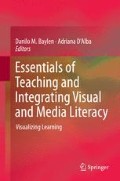Abstract
Information professionals such as archivists and librarians are faced with the challenge of preserving, describing, and providing access to information encoded on a variety of media, both text based and visual. While the visual and media literacy discourse recognizes the role of information professionals in visual, media, and information literacy education, the literature contains few pedagogical approaches those charged with training informational professionals at the graduate level. This chapter discusses one approach to visual and media literacy instruction in the Moving Image Archives course offered at the University of Pittsburgh School of Information Sciences, and suggests one method for visual and media literacy instruction at the graduate level. This technology-based approach addresses the “designing and creating” competencies from the Association of College and Research Libraries Visual Literacy Competency Standards for Higher Education, creating an environment that simulates production by introducing students to the tools and technologies of media production. This approach could also be used in other academic disciplines, such as film and media studies, where students learn to analyze and interpret specific media products, but do not engage directly with the technologies used to create these images.
Access this chapter
Tax calculation will be finalised at checkout
Purchases are for personal use only
References
Association of College and Research Libraries. (2011). ACRL Visual literacy competency standards for higher education. http://www.ala.org/acrl/standards/visualliteracy.Accessed May 14, 2014
Buckingham, D. (2003). Media education: Literacy, learning and contemporary culture. Malden: Polity.
Enticknap, L. (2013). Film restoration: The culture and science of audiovisual heritage. New York: Palgave Macmillan.
Garmire, E. M., & Pearson, G. (2006). Tech tally approaches to assessing technological literacy. Washington, DC: National Academies Press.
International Visual Literacy Association. (2010). What is visual literacy? http://www.ivla.org/drupal2/content/what-visual-literacy-0.Accessed May 14, 2014
Kahn, R., & Kellner, D. (2006). Reconstructing technoliteracy. In J. R. Drakers (Ed.), Defining technological literacy: Towards an epistemological framework. New York: Palgrave Macmillan.
Kaplan, E., & Mifflin, J. (2000). ‘Mind and sight’: Visual literacy and the archivist. In R. Jimerson (Ed.), American archival studies: Readings in theory and practice. Chicago: Society of American Archivists.
Kula, S. (2003). Appraising moving images: Assessing the archival and monetary value of film and video records. Lanham: Scarecrow Press.
Leigh, A. (2006). Context! context! context!: Describing moving images at the collection level. Moving Image, 6(1), 33–65.
Marcum, J. W., & O’Shea, D. I. (2009). Information technology literacy. In Encyclopedia of library and information sciences (3rd ed.). New York: Taylor and Francis. http://dx.doi.org/10.1081/E-ELIS3-120044482.
National Association of Media Literacy Education. (2014). Media literacy defined. http://namle.net/publications/media-literacy-definitions/.Accessed May 14, 2014
National Film Preservation Foundation. (2004). The film preservation guide: The basics for archives, libraries, and museums. San Francisco: NFPF.
Read, P., & Meyer, M. P. (Eds.). (2000). Restoration of motion picture film. Oxford: Butterworth Heinemann.
Ritzenthaler, M. L., & Vogt-O’Connor, D. (Eds.). (2006). Photographs: Archival care and management. Chicago: Society of American Archivists.
Sætervadent, T. (2006). The advanced projection manual. Brussels: FIAF.
Sætervadent, T. (2012). FIAF digital projection guide. Brussels: FIAF.
Schlak, T. (2008). Framing photographs, denying archives: The difficulty of focusing on archival photographs. Archival Science, 8, 85–101.
Schwartz, J. (1995). ‘We make our tools and our tools make us’: Lessons from photographs for the practice, politics, and poetics of diplomacy. Archivaria, 40, 40–74.
Schwartz, J. (2002). Coming to terms with photographs: Descriptive standards, linguistic ‘othering,’ and the margins of archivy. Archivaria, 54, 142–171.
Author information
Authors and Affiliations
Corresponding author
Editor information
Editors and Affiliations
Rights and permissions
Copyright information
© 2015 Springer International Publishing Switzerland
About this chapter
Cite this chapter
Mattock, L. (2015). Teaching Visual and Media Literacy Skills Through Media Production Technology. In: Baylen, D., D'Alba, A. (eds) Essentials of Teaching and Integrating Visual and Media Literacy. Springer, Cham. https://doi.org/10.1007/978-3-319-05837-5_12
Download citation
DOI: https://doi.org/10.1007/978-3-319-05837-5_12
Published:
Publisher Name: Springer, Cham
Print ISBN: 978-3-319-05836-8
Online ISBN: 978-3-319-05837-5
eBook Packages: Humanities, Social Sciences and LawEducation (R0)

